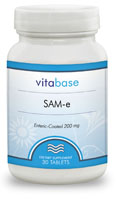| S-adenosylmethionine (SAMe) is a natural molecule synthesized from the amino acid methionine in the presence of magnesium and adenosine triphosphate (ATP). S-Adenosylmethionine is an essential ubiquitous metabolite central to many biochemical pathways, including transmethylation and polyamine biosynthesis. S-adenosylmethionine is a significant physiologic compound
that is present throughout body tissue and that takes part in a number of biologic reactions as a methyl group donor or an enzymatic activator during the synthesis and metabolism of hormones, neurotransmitters, nucleic acids, phospholipids, and proteins. It is naturally formed in the body from ATP and methionine. SAMe is an extremely important reactant in many biochemical reactions including transmethylation, transsulfation, and synthesis of amines.
S-adenosylmethionine participates in a great number of metabolic processes of fundamental importance for human organism, and consequently its deficiency lies at the basis of many organic malfunctions. SAMe is known to show a variety of actions, i.e. inhibition of neuronal death following ischemia, improvement of cerebral glucose utility, inhibition of brain edema, improvement of EEG, improvement of evoked potential, ameliorative action on motor function, and therefore reported to be important as a cure for stroke. In addition, a number of metabolites of SAM aid in the repair of connective tissue, including glutathione, polyamines, methylthioadenosine, and adenosine. Glutathione works as a scavenger of oxygen-related products. SAMe protects liver cells indirectly via its antioxidant products cysteine and glutathione, which help prevent damage by the excessive free radicals produced during alcohol intoxication.
S-adenosylmethionine (SAMe) is known as a substance existing in the living body and also as a methyl donor in the metabolism of living organisms. The release of the methyl group from SAMe is also the start of a "transsulfuration" pathway that produces all endogenous sulfur compounds. After donating its methyl group, SAMe is converted into S-adenosylhomocysteine, which in turn is hydrolyzed to adenosine and homocysteine. The amino acid cysteine may then be produced from the homocysteine. In higher organisms, SAMe plays a significant role in transmethylation processes in more than 40 anabolic or catabolic reactions involving the transfer of the methyl group of SAMe to substrates such as nucleic acids, proteins and lipids, among others. S-Adenosylmethionine proved to be effective in antagonizing bile secretion impairment induced by a wide range of hepatotoxins, including ethynylestradiol, taurolithocholate, chlorpromazine and alpha-naphthyl-isothiocyanate. The anticholestatic activity of SAMe may result from its role in the intermediate metabolism as this molecule is involved in transmethylation and transsulfuration reactions.
SAMe has been used to treat various disorders. In various forms of liver disease, SAMe acts as an anticholestatic agent. S-adenosylmethionine is necessary for the production of glutathione, the primary antioxidant found in the liver. Low levels of SAMe are believed to play a role in reducing the risk of certain cancers. SAMe has also been found effective in the treatment of Cholestasis. SAMe is also used in the treatment of fibromyalgia, osteoarthritis and depression. SAM may also function as a source of endogenous sulfur, which will increase sulfation of GAGs to be incorporated in proteoglycans. The inclusion of SAMe is particularly beneficial in instances of subclinical deficiencies of SAMe, occurring especially in elderly populations with higher risk of osteoarthritis. Cerebrospinal fluid (CSF) S-adenosylmethionine (SAM) levels were significantly lower in severely depressed patients than in a neurological control group. Reduced CSF S-adenosylmethionine levels in Alzheimer's disease have been reported. |
 SAM-e (s-Adenosylmethione or ademetrionine) is a powerful antioxidant helping counteract free radical damage in the body. SAM-e can significantly absorb moisture from the environment, which can lead to a compromise in its overall quality. Consequently, Vitabase SAM-e tablets are carefully enteric-coated for the strongest protection. Click here for more information.
SAM-e (s-Adenosylmethione or ademetrionine) is a powerful antioxidant helping counteract free radical damage in the body. SAM-e can significantly absorb moisture from the environment, which can lead to a compromise in its overall quality. Consequently, Vitabase SAM-e tablets are carefully enteric-coated for the strongest protection. Click here for more information.